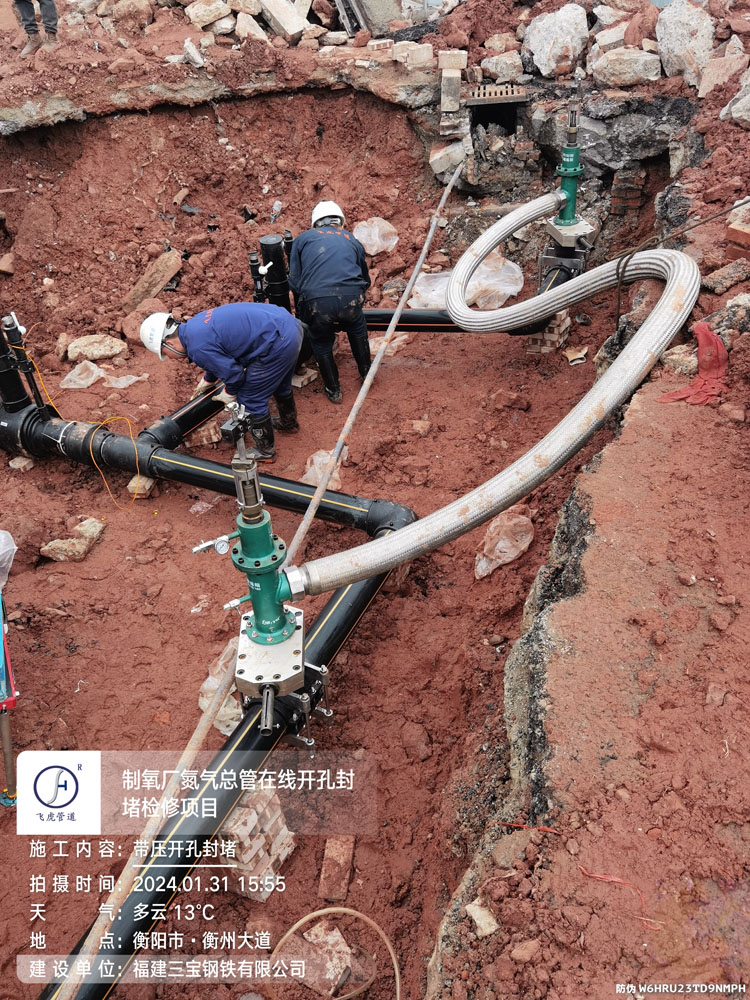The Importance of PE Hot Tapping in Modern Pipeline Systems
Pipeline systems play a vital role in transporting water, gas, fuel, and other essential resources to industries, municipalities, and communities. With growing infrastructure demands, it is no longer practical to shut down entire networks just to add a new connection or make modifications. This is where PE Hot Tapping for HDPE Pipelines becomes an indispensable solution. Unlike traditional methods that require full shutdowns and service interruptions, hot tapping allows engineers to create new access points while the pipeline remains active. This ensures continuous service, preventing costly disruptions for businesses and communities alike. In a world that depends on reliable energy and water distribution, the ability to upgrade and expand without halting operations is a significant advantage. As industries continue to evolve, PE hot tapping offers the adaptability and efficiency required for sustainable growth.
Understanding PE Hot Tapping for HDPE Pipelines
At its core, hot tapping is the process of connecting to a live pipeline without interrupting flow or pressure. When performed on HDPE (high-density polyethylene) pipelines, the process is referred to as PE Hot Tapping for HDPE Pipelines. This method involves using specialized fittings and drilling tools to create a new branch connection while the pipeline remains under pressure. HDPE is widely used in pipeline systems due to its flexibility, corrosion resistance, and durability, making it an excellent material for hot tapping. Unlike steel pipelines, which can be more complex and prone to corrosion, HDPE offers safer and longer-lasting solutions. The hot tapping technique minimizes risk by allowing controlled drilling under pressure with precise sealing mechanisms. This ensures that the live pipeline maintains its structural integrity and continues to function without leaks or service interruptions.
Step-by-Step Process of PE Hot Tapping for HDPE Pipelines
The procedure for hot tapping HDPE pipelines requires careful planning, specialized tools, and professional expertise. The first step involves a detailed site assessment, where engineers examine the pipeline’s diameter, pressure, and condition to ensure the system can safely undergo hot tapping. Next, a tapping sleeve or fitting is installed around the section of the pipeline where the new connection is required. Once the fitting is secured, a tapping machine with a specialized drill is used to bore into the live pipeline while maintaining pressure. During this process, flow is carefully monitored to ensure stability and safety. After the drilling is complete, the tapping machine retracts the cut section and leaves the new connection sealed within the fitting. The final step involves securing and testing the branch connection to confirm that it is leak-free and fully operational. Each stage requires precise coordination to ensure safety and performance, making it a task best handled by certified professionals.
Advantages of Using PE Hot Tapping in HDPE Pipeline Maintenance
There are numerous advantages to using PE Hot Tapping for HDPE Pipelines, particularly when compared to traditional shutdown methods. The most obvious benefit is the ability to maintain uninterrupted service, which is critical in industries such as gas distribution, water supply, and oil transportation. This eliminates the costs and inconvenience associated with draining pipelines, halting production, or temporarily shutting down entire systems. Another advantage lies in its flexibility, as hot tapping can be applied to pipelines of varying sizes and pressures. From small municipal water lines to large industrial transport systems, hot tapping provides a scalable solution. Additionally, this technique enhances environmental safety by reducing the chances of spills or leaks that might occur during traditional modification methods. By avoiding unnecessary downtime and minimizing risks, PE hot tapping offers a cost-effective and environmentally responsible option for pipeline operators.
Safety Considerations in PE Hot Tapping for HDPE Pipelines
Safety is the foundation of every hot tapping operation, especially when working with live pipelines carrying gas, fuel, or pressurized water. When performing PE Hot Tapping for HDPE Pipelines, trained technicians follow strict safety protocols to minimize risks. The process requires specialized hot tapping machines designed to withstand pressure while drilling into the pipeline. Engineers also perform pressure and flow analysis before the procedure to ensure that the pipeline can safely handle the process. Environmental safeguards, such as containment systems, are implemented to prevent accidental leaks or contamination. Compliance with industry standards and regulations is also essential, as this ensures that the procedure meets safety and performance requirements. Worker safety is equally important, with technicians using protective equipment and adhering to strict operational guidelines. By combining advanced technology with professional expertise, PE hot tapping ensures a safe and reliable method for live pipeline connections.
Common Applications of PE Hot Tapping in Different Industries
The versatility of PE Hot Tapping for HDPE Pipelines makes it applicable across a wide range of industries. In municipal infrastructure, it is frequently used for water distribution systems that cannot afford downtime during expansion or maintenance projects. Gas distribution companies rely on hot tapping to connect new customers or extend their service networks without interrupting supply. In the oil and fuel industry, where downtime translates into significant financial loss, hot tapping ensures continuous transportation while allowing for system upgrades. Industrial facilities, such as manufacturing plants, also use hot tapping to make modifications while keeping production running. Even large-scale infrastructure projects benefit from hot tapping when pipelines need to be integrated into existing systems. The adaptability of hot tapping across industries demonstrates why it has become a preferred method for live pipeline modifications worldwide.
The Role of Expertise and Advanced Equipment in PE Hot Tapping
Performing PE Hot Tapping for HDPE Pipelines successfully requires a combination of professional expertise and advanced equipment. Skilled technicians with hands-on experience are essential because hot tapping involves working under pressure in live systems. Without proper training and precision, risks can quickly escalate. The use of specialized fittings, tapping machines, and sealing devices ensures that the procedure is both safe and effective. Companies that invest in advanced technology are better equipped to handle pipelines of various sizes, pressures, and applications. Innovation also plays a key role in advancing hot tapping techniques, allowing for more efficient and safer operations over time. For businesses and municipalities, choosing a service provider with proven expertise and modern equipment is critical to project success. Ultimately, the reliability of PE hot tapping depends on the synergy between human skill and technological advancement.
Long-Term Value of PE Hot Tapping for HDPE Pipelines
Beyond its immediate benefits, PE Hot Tapping for HDPE Pipelines delivers significant long-term value to infrastructure systems. By avoiding shutdowns, operators save on both direct and indirect costs, such as labor, downtime, and lost productivity. The ability to scale and expand pipelines without major disruptions supports long-term infrastructure growth and adaptability. For industries with increasing demand, such as utilities and manufacturing, hot tapping provides a sustainable solution for ongoing development. The durability of HDPE pipelines combined with hot tapping technology ensures reliable performance for decades. Additionally, reducing risks of environmental spills or leaks enhances long-term compliance and public trust. By investing in hot tapping, organizations not only meet present demands but also prepare their systems for future expansion. This long-term perspective makes hot tapping an essential strategy in modern pipeline management.
Frequently Asked Questions (FAQ)
Q1. What makes PE hot tapping different from traditional pipeline connections?
PE hot tapping allows for new connections without shutting down or draining the pipeline. Traditional methods require halting service, which can cause costly interruptions.
Q2. Is PE hot tapping safe for high-pressure HDPE pipelines?
Yes, with proper equipment and trained technicians, hot tapping is safe for both low and high-pressure HDPE pipelines.
Q3. Can hot tapping be performed on all sizes of HDPE pipelines?
Hot tapping can be adapted for pipelines of various sizes and diameters, making it suitable for municipal, industrial, and commercial applications.
Q4. How long does a PE hot tapping procedure usually take?
The duration depends on pipeline size, pressure, and site conditions, but most hot tapping projects are completed within a few hours.
Q5. What industries benefit most from PE hot tapping services?
Industries such as water utilities, gas distribution, oil transport, and manufacturing facilities benefit greatly from hot tapping due to their need for continuous operations.











